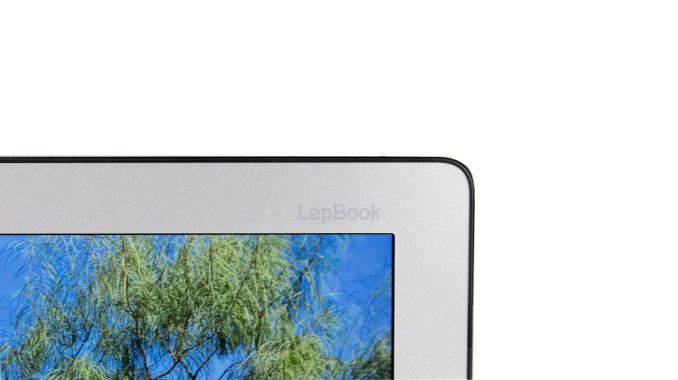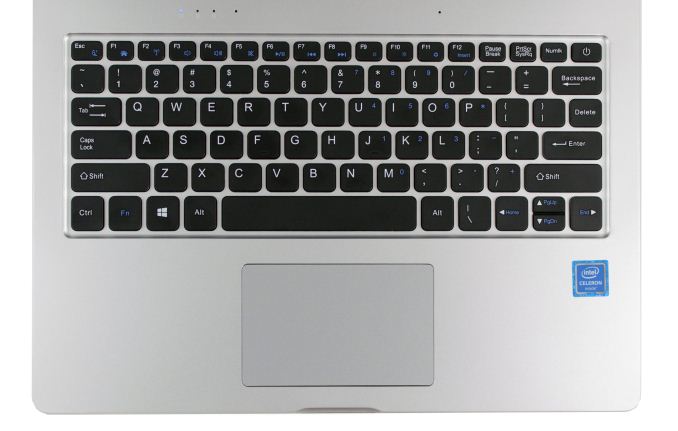The Chuwi LapBook 12.3 Review: Premium Feel, Budget Price
by Brett Howse on September 6, 2017 8:00 AM EST- Posted in
- Laptops
- Apollo Lake
- Goldmont
- Chuwi
Design
Since most of the internals are shared with Chuwi’s other offerings, such as the LapBook 14.1, and the Hi13 tablet, what sets the LapBook 12.3 apart from those is the design. The small numbering difference between the LapBook 14.1 and the 12.3 could easily fool someone into thinking they were very similar in design, but that’s not the case at all. Whereas the 14.1 model is your typical, budget laptop, with a plastic chassis, the LapBook 12.3 punches way above its weight with a full aluminum chassis. The plastic on the 14.1 was fine, and would be a very durable product, but aluminium really adds a big dash of premium to this budget device.
The 3:2 display is also very welcome here. Microsoft’s Surface lineup has proven that 3:2 works very well on the PC, whether in a portrait touch mode, or the more traditional landscape laptop mode, and that carries on here with the 12.3-inch 3:2 panel. Chuwi hasn’t been able to shrink the display bezels as much as it did in the LapBook 14.1, but on a smaller laptop, it would be tough to fit in the keyboard, trackpad, and all of the internal components if the display bezels were much smaller than they are. The bezels are the same color as the rest of the laptop though, although the bezel is plastic. This coloring makes the bezels all the more obvious to see, but for the price, it’s not a huge issue. The only real solution would be to add a larger display, and there’s a lot less options for 3:2 panels on the market.
The keyboard is exactly the same as the LapBook 14.1, and it offers decent travel and a good feel, but there’s no backlighting available. That’s also something that is to be expected at this price point, but it has to be pointed out, since it would be missed. Chuwi has also kept the somewhat strange keyboard layout, with the power button where Delete should be, and other keys shuffled around. The keyboard size and feel is fine, but the layout could use some work, and it would be best if Power wasn’t so easily pressed by mistake. It’s fairly frustrating to accidentally shut off your computer when you meant to make an edit.
The trackpad is all plastic, and is easily the biggest let-down in the Chuwi lineup. Good trackpads are hard to come by on Windows laptops, but the Chuwi model offers some of its own quirks as well. The two-finger scroll direction is the opposite of almost every other PC available, and there’s no drivers to let you swap it around if you wanted to. The trackpad feel is poor as well, thanks to the not smooth plastic surface and poor response. The money saved on the laptop would be well spent on a good mouse to use with it.
Chuwi continues its other quirks as well, with the single USB 3.0 port on the left, and single USB 2.0 port on the right, both upside down compared to every other laptop. That’s not the end of the world, but certainly odd enough to cause you confusion a few times during the USB superposition games everyone must play trying to connect devices. There’s also a microSD slot, and mini HDMI connector as well.
Overall, the design is quite impressive for a laptop hovering just over the $300 mark. The aluminum construction offers a very premium feel to the laptop, and the build quality and hinge feel solid despite the price. The small size will likely scare away some buyers, but the keyboard feels just as good as its larger cousin, the LapBook 14.1.














60 Comments
View All Comments
ianmills - Thursday, September 7, 2017 - link
I guess the bigger one has a copper heatsink. Techtablets has a bunch about this. Adding a copper heatsink can improve performance quite a bitvanilla_gorilla - Wednesday, September 6, 2017 - link
This doesn't seem that shocking of a price. For $270 you can get an all aluminum Acer Chromebook 14 with a 1080p IPS display, 4GB RAM and 32GB eMMC. And the acer has been available for several months.tipoo - Wednesday, September 6, 2017 - link
I have it. I hope they updated it to Apollo Lake soon, the Braswell CPU is pretty slow.kefkiroth - Wednesday, September 6, 2017 - link
I think it's at least a little surprising. The LapBook 12.3 has 2 more GB of RAM, a slightly better processor, a much higher resolution display, and double the storage for just ~$60 more.systemBuilder - Wednesday, September 6, 2017 - link
RAM is $10/GB = $20.Flash is $0.50/GB = $16
Better screen, I guess, is about $18 more, markup is assumed 10%.
tipoo - Wednesday, September 6, 2017 - link
I don't think Windows is free in this screen sizenotashill - Wednesday, September 6, 2017 - link
What BIOS version was used for testing? I've seen some people on the Chuwi forums say that the most recent BIOS update significantly raised maximum brightness, seems to be dated 2017/06/12.See: http://forum.chuwi.com/forum.php?mod=viewthread&am...
http://forum.chuwi.com/thread-4473-1-1.html
jabber - Wednesday, September 6, 2017 - link
If you can put Neverware on this and you have a great Chromebook!BrokenCrayons - Thursday, September 7, 2017 - link
I's prefer a Linux disto if looking into an alternative OS. Chromebooks are distressingly limited in capability. The end user is probably better off leaving Windows in place since it can do anything Chrome OS can do and a lot more.jabber - Sunday, September 10, 2017 - link
Well as this is essentially a Chromebook re-purposed for Windows I'd say ChromeOS would work better. I use a mix of Windows and ChromeOS machines and it is so nice to use a Machine that doesnt take ages to update and boot etc. ChromeOS just works and for a lot of people that's all they want. If not why did MS bother with the farce that is Windows S?